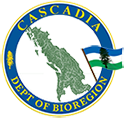KALAKALA
[KUH-lah-kuh-lah] — noun.
Meaning: Bird; a fowl; goose; a flock of birds; a winged insect; a wing.
Origin: Chinook i-ku-la-ku-lu ‘(male) goose’; i-k’lak’la ‘(male) geese’; ultimately derived from a Chinookan verbal stem -ka or -ga ‘to fly’; -galal ‘flying’, said to be an imitation of the notes of a wild goose when flying, hence flying bird. There may be an etymological link between this and the Chinook Wawa word kwalal-kwalal ‘gallop’, in the sense of a horse “flying” at full gallop.
‘Kalakala’, or occasionally, ‘kullakala’ and even ‘kgalakgala’, is the Chinook Wawa word for ‘bird’ which forms the bases for many species of birds, such “tenas kalakala” (sparrow; swallow; lark), “illahee kalakala” (quail), and “kwass kalakala” (pidgeon), as well as things related to birds, such as “kalakala house” (bird’s nest) and “kalakala tupso” (feather; bird down), “kalakala yaka tupso” (quill; the wings of a bird), and “sing kahkwa kalakala” (bird-song; warble).
The term “lapeep kullakala” (pipe bird) was given to a variety of raptors, whose feathers were often used to ornament smoking pipe-stems, and the word forms the base of the Chinook Wawa word “kalakalahma” (goose). It’s even used to describe flying animals that aren’t birds, such as “polaklie kalakala” (bat). Flies were also sometimes referred to as “tenas kalakala”, though the french loan-word “lemosh” was often used to avoid confusion.
The word also lends its name to the Motor Vessel Kalakala, a car and passenger ferry which plied the waters between Port Angeles and Victoria from 1935 until her retirement in 1967. The first commercial vessel to ever be equipped with radar to help guide it through fog and at night, the MV Kalakala was also notable for her unique streamlined superstructure, art deco styling, and luxurious amenities.
Kalakala mural painted in the town of Port Angeles, Washington.





Post a comment